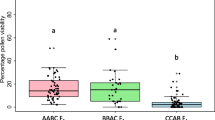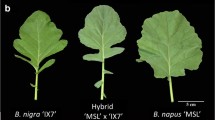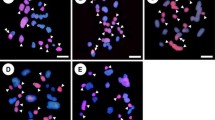Abstract
Gene introgression into allopolyploid crop species from diploid or polyploid ancestors can be accomplished through homologous or homoeologous chromosome pairing during meiosis. We produced trigenomic Brassica interspecific hybrids (genome complements AABC, BBAC and CCAB) from the amphidiploid species Brassica napus (AACC), Brassica juncea (AABB) and Brassica carinata (BBCC) in order to test whether the structure of each genome affects frequencies of homologous and homoeologous (both allosyndetic and autosyndetic) pairing during meiosis. AABC hybrids produced from three genotypes of B. napus were included to assess the genetic control of homoeologous pairing. Multi-colour fluorescent in situ hybridisation was used to quantify homologous pairing (e.g. A-genome bivalents in AABC), allosyndetic associations (e.g. B–C in AABC) and autosyndetic associations (e.g. B–B in AABC) at meiosis. A high percentage of homologous chromosomes formed pairs (97.5–99.3%), although many pairs were also involved in autosyndetic and allosyndetic associations. Allosyndesis was observed most frequently as A–C genome associations (mean 4.0 per cell) and less frequently as A–B genome associations (0.8 per cell) and B–C genome associations (0.3 per cell). Autosyndesis occurred most frequently in the haploid A genome (0.75 A–A per cell) and least frequently in the haploid B genome (0.13 B–B per cell). The frequency of C–C autosyndesis was greater in BBAC hybrids (0.75 per cell) than in any other hybrid. The frequency of A–B, A–C and B–C allosyndesis was affected by the genomic structure of the trigenomic hybrids. Frequency of allosyndesis was also influenced by the genotype of the B. napus paternal parent for the three AABC (B. juncea × B. napus) hybrid types. Homoeologous pairing between the Brassica A, B and C genomes in interspecific hybrids may be influenced by complex interactions between genome structure and allelic composition.


Similar content being viewed by others
Abbreviations
- BAC:
-
Bacterial artificial chromosome; a DNA construct inserted into a bacterial plasmid
- DAPI:
-
4′,6-Diamidino-2-phenylindole; a blue fluorescent stain that binds strongly to DNA
- FISH:
-
Fluorescent in situ hybridisation; a cytogenetic technique used to detect the presence or absence of specific DNA sequences on chromosomes
- GISH:
-
Genomic in situ hybridisation; a specific type of FISH whereby genomic DNA is used as a probe
- PMC/s:
-
Pollen mother cell/s. Cells produced by the male generative organs in plants which subsequently undergo meiosis and cell division to develop into (usually) four haploid pollen grains
References
Alix K, Joets J, Ryder CD et al (2008) The CACTA transposon Bot1 played a major role in Brassica genome divergence and gene proliferation. Plant J 56:1030–1044
Armstrong KC, Keller WA (1981) Chromosome pairing in haploids of Brassica campestris. Theor Appl Genet 59:49–52
Armstrong KC, Keller WA (1982) Chromosome pairing in haploids of Brassica oleracea. Can J Genet Cytol 24:735–739
Attia T, Busso C, Röbbelen G (1987) Digenomic triploids for an assessment of chromosome relationships in the cultivated diploid Brassica species. Genome 29:326–330
Axelsson T, Bowman CM, Sharpe AG, Lydiate DJ, Lagercrantz U (2000) Amphidiploid Brassica juncea contains conserved progenitor genomes. Genome 43:679–688
Basunanda P, Spiller TH, Hasan M, Gehringer A, Schondelmaier J, Lühs W, Friedt W, Snowdon R (2007) Marker-assisted increase of genetic diversity in a double-low seed quality winter oilseed rape genetic background. Plant Breed 126:581–587
Becker HC, Engqvist GM, Karlsson B (1995) Comparison of rapeseed cultivars and resynthesized lines based on allozyme and RFLP markers. Theor Appl Genet 91:62–67
Cheung F, Trick M, Drou N et al (2009) Comparative analysis between homoeologous genome segments of Brassica napus and its progenitor species reveals extensive sequence-level divergence. Plant Cell 21:1912–1928
Chèvre AM, Barret P, Eber F et al (1997) Selection of stable Brassica napus–B. juncea recombinant lines resistant to blackleg (Leptosphaeria maculans). 1. Identification of molecular markers, chromosomal and genomic origin of the introgression. Theor Appl Genet 95:1104–1111
Cowling WA (2007) Genetic diversity in Australian canola and implications for crop breeding for changing future environments. Field Crops Res 104:103–111
Crouch JH, Lewis BG, Mithen RF (1994) The effect of A genome substitution on the resistance of Brassica napus to infection by Leptosphaeria maculans. Plant Breed 112:265–278
Ge XH, Li ZY (2007) Intra- and intergenomic homology of B-genome chromosomes in trigenomic combinations of the cultivated Brassica species revealed by GISH analysis. Chromosome Res 15:849–861
Harberd DJ (1950) A cytological study of species relationships in Brassica. University of Wales, Aberystwyth
Harberd DJ, McArthur ED (1980) Meiotic analysis of some species and genus hybrids in the Brassiceae. In: Tsunoda S, Hinata K, Gomez-Campo C (eds) Brassica crops and wild allies: biology and breeding. Japan Scientific Societies, Tokyo, pp 65–87
Howell EC, Barker G, Jones GH et al (2002) Integration of the cytogenetic and genetic linkage maps of Brassica oleracea. Genetics 161:1225–1234
Jenczewski E, Eber F, Grimaud A et al (2003) PrBn, a major gene controlling homeologous pairing in oilseed rape (Brassica napus) haploids. Genetics 164:645–653
Lagercrantz U, Lydiate DJ (1996) Comparative genome mapping in Brassica. Genetics 144:1903–1910
Leflon M, Eber F, Letanneur JC et al (2006) Pairing and recombination at meiosis of Brassica rapa (AA) x Brassica napus (AACC) hybrids. Theor Appl Genet 113:1467–1480
Leflon M, Brun H, Eber F et al (2007) Detection, introgression and localization of genes conferring specific resistance to Leptosphaeria maculans from Brassica rapa into B. napus. Theor Appl Genet 115:897–906
Leitch AR, Leitch IJ (2008) Genomic plasticity and the diversity of polyploid plants. Science 320:481–483
Liu Z, Adamczyk K, Manzanares-Dauleux M et al (2006) Mapping PrBn and other quantitative trait loci responsible for the control of homeologous chromosome pairing in oilseed rape (Brassica napus L.) haploids. Genetics 174:1583–1596
Lysak MA, Koch MA, Pecinka A, Schubert I (2005) Chromosome triplication found across the tribe Brassiceae. Genome Res 15:516–525
Morinaga T (1929) Interspecific hybridisation in Brassica II. The cytology of F1 hybrids of B. cernua and various other species with 10 chromosomes. Jpn J Bot 4:277–289
Nagpal R, Raina SN, Sodhi YS et al (1996) Transfer of Brassica tournefortii (TT) genes to allotetraploid oilseed Brassica species (B. juncea AABB, B. napus AACC, B. carinata BBCC): homoeologous pairing is more pronounced in the three-genome hybrids (TACC, TBAA, TCAA, TCBB) as compared to allodiploids (TA, TB, TC). Theor Appl Genet 92:566–571
Nelson MN, Mason AS, Castello M-C, Thomson L, Yan G, Cowling WA (2009) Microspore culture preferentially selects unreduced (2n) gametes from an interspecific hybrid of Brassica napus L. × Brassica carinata Braun. Theor Appl Genet 119:497–505
Nicolas SD, Mignon GL, Eber F et al (2007) Homeologous recombination plays a major role in chromosome rearrangements that occur during meiosis of Brassica napus haploids. Genetics 175:487–503
Nicolas SD, Leflon M, Liu Z et al (2008) Chromosome ‘speed dating’ during meiosis of polyploid Brassica hybrids and haploids. Cytogenet Genome Res 120:331–338
Nicolas SD, Leflon M, Monod H et al (2009) Genetic regulation of meiotic cross-overs between related genomes in Brassica napus haploids and hybrids. Plant Cell 21:373–385
Olsson G, Hagberg A (1955) Investigations on haploid rape. Hereditas 41:227–237
Parkin IAP, Sharpe AG, Keith DJ, Lydiate DJ (1995) Identification of the A and C genomes of amphidiploid Brassica napus (oilseed rape). Genome 38:1122–1131
Parkin IAP, Sharpe AG, Lydiate DJ (2003) Patterns of genome duplication within the Brassica napus genome. Genome 46:291–303
Parkin IAP, Gulden SM, Sharpe A et al (2005) Segmental structure of the Brassica napus genome based on comparative analysis with Arabidopsis thaliana. Genetics 171:765–781
Prakash S (1973) Haploidy in Brassica nigra Koch. Euphytica 22:613–614
Prakash S, Chopra VL (1990) Reconstruction of allopolyploid Brassicas through non-homologous recombination: introgression of resistance to pod shatter in Brassica napus. Genet Res 56:1–2
Prakash S, Chopra VL (1993) Genome manipulations. In: Labana KS, Banga KS, Banga SS (eds) Breeding oilseed Brassicas. Springer, Berlin, pp 108–133
R Development Core Team (2008) R: a language and environment for statistical computing. R Foundation for Statistical Computing, Vienna, Austria. ISBN 3-900051-07-0, URL http://www.R-project.org
Ramanujam S, Srinivasachar D (1943) Cytogenetic investigations in the genus Brassica and the artificial synthesis of B. juncea. Indian J Genet Plant Breed 3:73–88
Riley R, Miller TE (1970) Meiotic chromosome pairing in Triticale. Nature 227:82–83
Rygulla W, Snowdon RJ, Eynck C et al (2007) Broadening the genetic basis of Verticillium longisporum resistance in Brassica napus by interspecific hybridization. Phytopathology 97:1391–1396
Saal B, Brun H, Glais I, Struss D (2004) Identification of a Brassica juncea-derived recessive gene conferring resistance to Leptosphaeria maculans in oilseed rape. Plant Breed 123:505–511
Sasaoka T (1930) Karyological observations in different interspecific hybrids of Brassica. Jpn J Genet 6:21–32
Seyis F, Snowdon RJ, Luhs W, Friedt W (2003) Molecular characterization of novel resynthesized rapeseed (Brassica napus) lines and analysis of their genetic diversity in comparison with spring rapeseed cultivars. Plant Breed 122:473–478
Sheidai M, Noormohamandi Z, Sotodeh M (2006) Cytogenetic variability in several canola (Brassica napus) cultivars. Caryologia 59:267–276
Song K, Osborn TC (1992) Polyphyletic origins of Brassica napus: new evidence based on organelle and nuclear RFLP analyses. Genome 35:992–1001
Song K, Tang K, Osborn TC (1993) Development of synthetic Brassica amphidiploids by reciprocal hybridization and comparison to the natural amphidiploids. Theor Appl Genet 86:811–821
Talbert LE, Smith LY, Blake NK (1998) More than one origin of hexaploid wheat is indicated by sequence comparison of low-copy DNA. Genome 41:402–407
U N (1935) Genome-analysis in Brassica with special reference to the experimental formation of B. napus and peculiar mode of fertilization. Jpn J Bot 7:389–452
Udall JA, Quijada P, Osborn TC (2005) Detection of chromosomal rearrangements derived from homeologous recombination in four mapping populations of Brassica napus L. Genetics 169:967–979
Yu F, Lydiate DJ, Rimmer SR (2005) Identification of two novel genes for blackleg resistance in Brassica napus. Theor Appl Genet 110:969–979
Acknowledgements
Travel of the first author was sponsored by the Mike Carroll Travelling Fellowship and a Convocation Postgraduate Research Travel Award from The University of Western Australia (Perth, Australia). This research was funded by INRA (Institut National de la Recherche Agronomique, Le Rheu, France) and Australian Research Council Linkage Project LP0667805 with industry partners Norddeutsche Pflanzenzucht Hans-Georg Lembke KG (Germany) and the Council of Grain Grower Organisations Ltd (Australia).
Author information
Authors and Affiliations
Corresponding author
Additional information
Responsible Editor: Jiming Jiang.
Electronic supplementary material
Below is the link to the electronic supplementary material.
Supplementary Table 4
Frequency of observations (mean number per cell and range) for various chromosome configurations at meiosis I in 40 pollen mother cells (PMCs) of trigenomic Brassica interspecific hybrids created from crosses between B. juncea, B. napus and B. carinata. Multi-colour FISH was used to label chromosomes in the Brassica A, B and C genomes (n = 10, n = 8 and n = 9 chromosomes, respectively). AABC-1, AABC-2 and AABC-3 result from crosses between three different B. napus cultivars (doubled haploid derivatives of ‘Surpass400’, ‘Monty’ and ‘Westar’, respectively) and a single B. juncea genotype. (DOC 78 kb)
Rights and permissions
About this article
Cite this article
Mason, A.S., Huteau, V., Eber, F. et al. Genome structure affects the rate of autosyndesis and allosyndesis in AABC, BBAC and CCAB Brassica interspecific hybrids. Chromosome Res 18, 655–666 (2010). https://doi.org/10.1007/s10577-010-9140-0
Received:
Revised:
Accepted:
Published:
Issue Date:
DOI: https://doi.org/10.1007/s10577-010-9140-0




